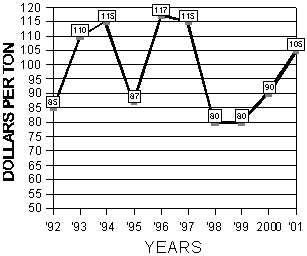Alfalfa Report
Yuma County, Arizona
November 5, 2001
Yuma County Office
2200 W. 28th Street, Ste. 102
Yuma, AZ 85364
(928) 726-3904
(928) 726-8472 FAX
Production Update:
PDF version, 40KB
Starter Fertilizer: Starter Fertilizer Nitrogen is often recommended at planting time as a starter fertilizer for alfalfa. Nitrogen fertilizer may stimulate growth of alfalfa seedlings. However, nitrogen may also stimulate growth of weeds and will delay nodulation until the nitrogen level in the soil is decreased. The amount of nitrogen applied as a starter fertilizer should be in the range of 25 to 50 pounds of N per acre and rates above 50 pounds of N per acre are considered excessive.
Insect Management: Egrets, Ibis, gulls, and, redwing black birds are commonly seen in alfalfa fields. Birds are important predators of various insect pests in alfalfa including the very damaging granulate cutworm. Egrets, Ibis and gulls are often seen at the leading edge of irrigation water eating crickets and worms forced to move or drown. These birds feed during the day and roost at night. Therefore, they only eat the cutworms in lands where water is run during daylight hours. Black birds eat cutworms, other worm pests, and aphids on alfalfa stems. NOTE: On November 26th from 6:00 - 8:00pm, the Department of Agricultural will hold a general meeting presenting the new pesticides rules. This meeting will be held in the auditorium at the Yuma County Cooperative Extension Service (see address above). There is no registration required. If you need further information, contact Linda Fish at 602-542-3578 or Debra Atkins at 602-542-3579.
Weed Control: Nettleleaf goosefoot (chenopodium murale) and common
lambsquarters (chenopodium album) are closely related weeds but respond
differently to same herbicides. Pursuit, for instance, will control goosefoot
but not lambsquarters. Lambsquarters is pale green with a rough surface
while goosefoot is dark green with a slick waxy surface.
| Market Summary |
High
|
Low
|
Average
|
Off grade
|
| Past 2 Weeks (Oct. 23, 2001 to Nov. 5, 2001) |
110
|
100
|
105
|
80-98
|
| Last Year (Oct. 23, 2001 to Nov. 5, 2000) |
100
|
85
|
90
|
70-85
|
10 Year Summary (Oct. 23, to Nov. 5,
1992-2001):

Issued in furtherance of Cooperative Extension work, acts of May 8 and June 30, 1914, in cooperation with the U.S. Department of Agriculture, James A. Christenson, Director Cooperative Extension, College of Agriculture and Life Sciences, The University of Arizona.
The University of Arizona is an equal opportunity, affirmative action institution. The University does not discriminate on the basis of race, color, religion, sex, national origin, age, disability, veteran status, or sexual orientation in its programs and activities.
Any products, services, or organizations that are
mentioned, shown, or indirectly implied in this web document do not imply
endorsement by The University of Arizona.
Information provided by:
Barry Tickes, btickes@ag.arizona.edu Extension Agent, Yuma County
Michael Ottman, mottman@ag.arizona.edu Agronomy Specialist
College of Agriculture, The University of Arizona.
Eric Natwick, etnatwick@ucdavis.edu UCCE Imperial County - Farm Advisor
University of California, Davis, CA.
Material written November 5, 2001.
Forages: Crop Mgmt | Soil Mgmt | Irrigation | Alfalfa Reports | Insects | Diseases | Weeds | Pesticides
Home | Other Crops | Forages
For more Arizona Production Ag Information:
Home | Cotton | Veggies| Forages | Grains | Citrus | Crop x Crop | Insects | Diseases| Weeds | Pesticides | News | Weather | Research | Photos | Contacts | General Info. | Site Map
Copyright © 2001 University of Arizona,
College of Agriculture and Life Sciences
Webmaster: Al Fournier (fournier@ag.arizona.edu)